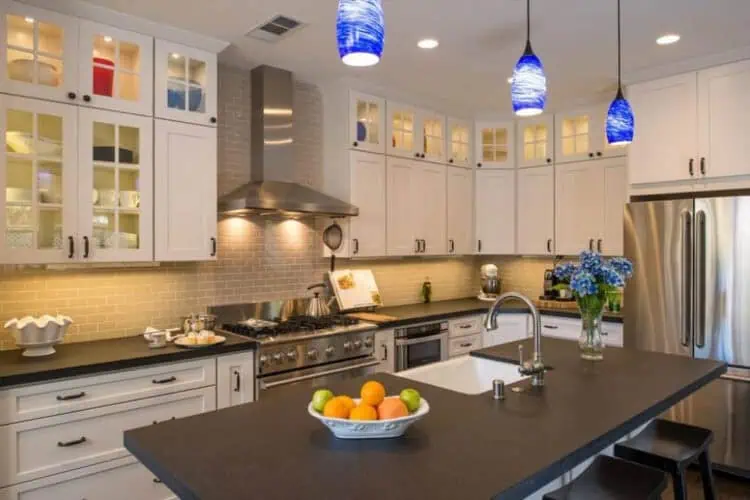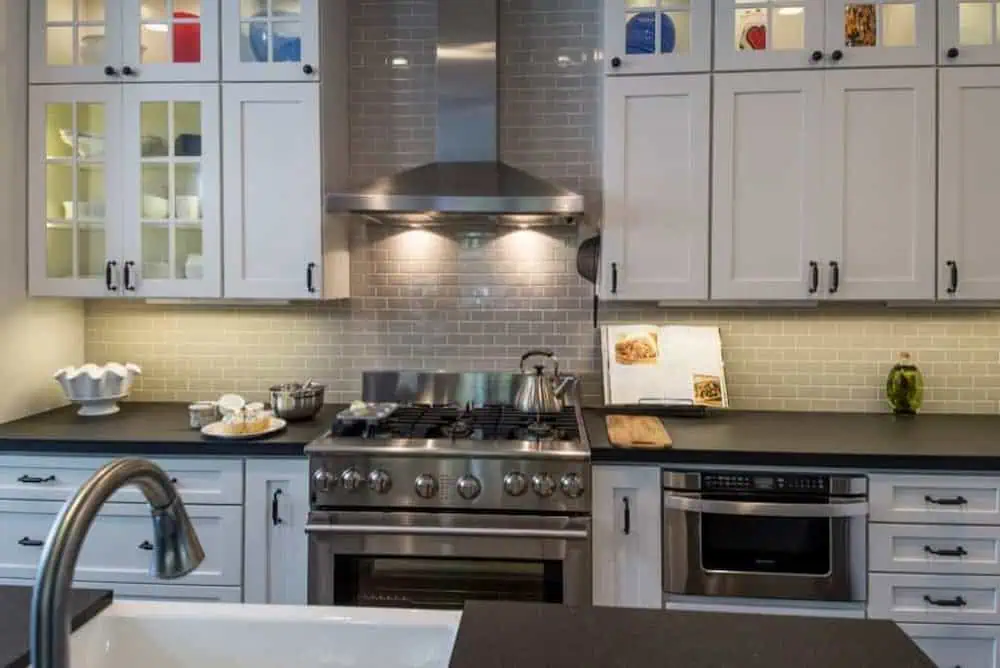
- By Remodel Works
- In Countertops
Leathered Granite: Introduction, Pros, Cons, How to Care for It & More
If you’re getting ready to call kitchen and bathroom remodelers in Rancho Panasquitos and start your project, then you probably already know that granite countertops are almost a staple in modern and stylish spaces. Thanks to its durability and the natural beauty of its colors and textures, granite has been one of the building material favorites for ages.
Aside from polished and honed finish options, a new trend is catching attention: leathered granite. In this article, we will explore what makes leathered granite a fun alternative for your remodeling project, including its benefits, maintenance, and more.
What is leathered granite?
Granite is a popular material, and its polished variant is fairly common in fine kitchens all around the world. The high sheen and smooth surface make it a reasonably elegant and easy-to-maintain choice, especially for kitchen countertops. Honed granite, on the other hand, stops the sandblasting process before it achieves that highly polished gleam. Its look is more earthy and casual, although the process tends to wash out the natural color of the stone.
Not long ago, your options would have stopped there. Honed and polished may be the most common ways to treat granite, but there’s a new trend worth considering: leathering. This process brings you the best of the natural stone’s beauty, including its color, textured look, and tactile appeal.
The leathering process
A meticulous and labor-intensive process, granite leathering should ideally be performed only by skilled professionals. But what does this process look like? To achieve that signature textured and matte look, experts use a diamond-tipped brush to repeatedly grind over the stone’s surface.
This process removes minor imperfections but preserves the natural patterns and contours of the granite. Plus, it allows for a custom level of texture too, so you can achieve final looks ranging from nearly smooth to distinctly rugged. Once your granite reaches the desired finish, it’s typically sealed to protect the surface and is then ready for installation.
What are the advantages and disadvantages of leathered granite?
Like any material, leathered granite comes with its own set of pros and cons. Let’s dive into the most important ones below.
Advantages of leathered granite
If you’re looking to discover why leathered granite is gaining popularity, here are some of it’s unique benefits:
Unique, rustic style
Because of its slightly dulled hue and rough texture, leathered granite has a particular rustic charm perfect for historic homes. It’s usually seen on countertops and vanity exteriors and can bring a distinct, antiqued, rustic look to any standard surface.
Although a polished finish, with its high gloss and sheen, has its own elegance and quality, leathering makes the look more natural, as if the material was quarried from the side of a mountain that same day. With it, even otherwise overlooked surfaces get a unique appeal. Leathered granite comes in a variety of tones and textures, so you’re sure to find just the hue and feel you’re looking for.
Amazing texture
With leathering, you can achieve an almost perfectly smooth, super-texturized, and any desired feel in between. It all depends on how far you go with the leathering process, so you can essentially choose how well you want the natural texture of the cut stone to show. Honed finishes typically don’t offer this same level of customization.
Granite can have some wonderful natural texture to it that will be lost in the overzealous sandblasting of traditional finishes. But a leathered finish will feel genuine and natural even to the touch. Suffused with history and eons of mineral memory, granite’s true texture will fascinate and thrill your guests while looking incredible as well.
Natural stone color
Often used on darker types of granite, like black pearl for example, leathering brings out the natural colors of the stone while staying a few steps away from the high sheen achieved in the polishing process. A happy medium between a honed and polished surface, leathering dismisses the washed-out or overly shiny conventions in favor of a textured appearance that shows off the all-too-often disregarded color of the granite itself.
Whether your dream granite countertop is absolute black, kashmir, or green ocean, leathering will make it pop. Where honing tends to dull the natural hue of a stone and polishing misconstrues sheen for shade, leathering allows the color of your stone to become the true star of the kitchen, bath, or outdoor area.
Hard to stain
The unique texture of leathered granite offers inherent benefits that make it a practical and stain-resistant choice for countertops. The process of leathering tightens the stone’s natural pores, which creates surfaces that are much harder to damage by staining. Unlike polished or honed finishes, spills are less likely to penetrate and leave lasting marks on leathered granite.
This textured surface also minimizes the visibility of fingerprints and water spots, a major advantage for those who prefer low-maintenance countertops. Additionally, the tighter pores contribute to improved bacterial resistance, making leathered granite a more hygienic option compared to smoother finishes. This inherent quality is often overlooked but is a significant advantage, particularly in high-use areas like kitchens.
Disadvantages of leathered granite
Though leathered granite tops have a lot of advantages, there are also some drawbacks to this particular finish. Let’s take a look at some of them:
Easier to scratch
While the textured surface of leathered granite offers many advantages, it also comes with the potential vulnerability to chipping and cracking. The very grooves and imperfections responsible for its unique look can also make it easier to damage with sharp or hard objects. Such impacts can mar the surface and leave unsightly chalky patches or stone dust.
The best way to handle this side of leathered granite is to make sure the surface is properly treated with a high-quality sealant that easily enters the pores. For many, natural contours and grooves are the main reasons to choose this finish, so it’d be a shame to see those features become a source of stress and frustration.
Trickier to clean
Similarly, the natural, textured surface of leathered granite makes it harder to get noticeably dirty or stained, but it also makes wiping and cleaning harder. With leathered textures, crumbs can settle into the crevices, and liquids can pool in the grooves. But this will depend largely on the specific texture you choose. Rougher ones naturally tend to trap more debris, while smoother textures are generally easier to wipe down.
If ease of maintenance is important to you, you should consider this when picking your finish. You’ll still be able to clean your countertops, you just need to use a regular brush or a hand broom and a damp cloth instead of wiping it down. Plus, because the surface is stain-resistant, leathered granite is hard to damage with spills, even if you don’t address them instantly.
How to maintain leathered granite countertops?
Caring for your leathered granite is, thankfully, a little less complicated than it would be for polished or honed stone. This is in huge part thanks to the ability of a leathered finish to hide smudges and stains, so you can rest assured that your granite will keep looking great where its honed and polished cousins would seem shabby. Similarly, watermarks will be a thing of the past on your new and improved countertops.
The high gloss and reflectivity of polished granite make it all too easy to smudge, stain, and weather, but also easy to wipe down. Honed granite, on the other hand, will stay relatively free of smudges and visible stains. But with both, at the end of the day, you’d be sacrificing color and beauty for efficiency. This sacrifice, worth it or not, does not actually need to be made as leathering can do all of the above without washing out your granite’s natural hue or requiring daily cleaning. You’ll also be avoiding all the waxing and oiling necessary with soapstone.
Should you seal leathered granite?
Although most manufacturers routinely seal granite countertops, there’s an ongoing debate about whether this is actually necessary.
On one hand, sealing adds a layer of protection that makes the stone more resistant to stains and damage. Sealants can also be stripped and reapplied if need be, which can potentially save you from costly and premature countertop replacements. However, there’s always the risk of unsightly sealant imperfections like brushstrokes or bubbles, which can diminish the natural, textured beauty of your leathered granite.
On the other hand, skipping the sealant preserves the natural matte finish and avoids the potential imperfections of many sealants and enhancers. Leathered granite’s inherent stain and smudge resistance, coupled with its natural antibacterial properties due to tightened pores, can make sealing seem unnecessary. However, not sealing comes with risks and leaves the surface more vulnerable. Wine stains and permanent markers are the unsealed countertops’ worst enemies.
Ultimately, the decision to seal or not to seal rests with you, so weigh the pros and cons carefully. Sealing offers enhanced protection and peace of mind while avoiding it maintains the natural beauty and feel of the stone. Need durability and a long lifespan more than the completely natural look? Remember, a sealed leathered granite countertop is virtually impervious to stains and built to last for years to come.
Is leathered granite a good choice?
In recent years, leathered granite has rapidly gained popularity and is now somewhat of a standard for designer residences all over. This finish, with its practicality and natural beauty, can charm even the pickiest of cooks. Leathered granite’s unique, satisfying tactile element is both its most important trait and an often overlooked factor when choosing countertop materials. This incredibly satisfying tactile element
Whether gracing your kitchen, bathroom, or outdoor space, leathered granite adds a touch of sophistication and warmth. Its durability and stain resistance make it a practical choice for high-traffic areas, while its customizable texture allows you to tailor the look to your preferences.
Leathered granite truly strikes a balance between rustic charm and modern elegance and gives you a low-maintenance surface that is both visually pleasing and incredibly functional. If you’re looking for a countertop that stands out from the crowd, leathered granite is certainly worth considering. Its timeless beauty and inherent practicality make it a valuable addition to any home.
Who are the most dependable kitchen and bathroom remodelers in Rancho Penasquitos?
If you’re thinking about upgrading your kitchen or bathroom countertops with the timeless elegance of leathered granite, Remodel Works is here to bring your vision to life. As your trusted full-service remodeling contractor, we specialize in a wide range of projects, from cosmetic kitchen enhancements and meticulous luxury vinyl flooring installations to full home transformations.
With a proven track record of successful projects and a team of dedicated professionals, we deliver exceptional results every time. We have access to the finest materials, employ industry-leading techniques, and prioritize open communication throughout the process.
Whether your home is nestled in the heart of Rancho Penasquitos, near the beautiful Black Mountain Open Space Park, or anywhere in the surrounding areas, we’re ready to help. Contact us today to discuss your project and discover how we can elevate your living spaces!














